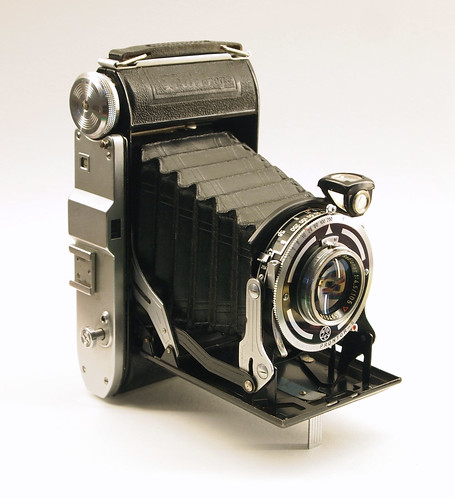 |
| Baldalux 6x9 folding camera |
The
Baldalux is a mid-range workaday 6x9 format folding camera, and I hadn't previously thought about writing a blog post about it until recent results from scanning a number of negatives I had shot while in Berlin last summer (although the posts on
Delta 3200 and
Verichrome were illustrated with images shot using the camera). The images made me re-evaluate the camera. I often like to have a 6x9 folding camera with me when travelling for landscape shots, and I've used my
Agfa Record I camera for this purpose in the past, but the Baldalux has features to make me favour it over the Record. Some of these features are pretty mundane, such as having the original ever-ready case, and the fact I've got a yellow push-on filter that fits the lens; it does have a better shutter though, and although I haven't done any meaningful comparisons, the Baldalux's Radionar lens seems to perform better than the Record's Agnar.
The Baldalux was manufactured by
Balda-Werk Bünde, the West German company arising from the pre-war Balda, which was based in Dresden (the East German plant became Belca). Like a number of German camera makers, Balda-Werk Bünde products were often rebranded for sale by other distributors and export to other markets, and so appear under different names. This is the case here, although the camera model being called Baldalux clearly points to its origins. My camera has 'Zodel reg.' stamped on the leatherette on the front of the camera (I've seen other examples on the web where the lettering here is Baldalux - one wonders whether the superfluous 'reg.' was just added to make the text a better visual fit). It also has a fading water-slide transfer label for Wallace Heaton, obscuring the Balda-Werk Bünde branding. Zodel was a brand name used by
Wallace Heaton, a London based distributor, to rebadge their cameras. I also have a
6.5x9 plate camera from the 1930s with the Zodel brand.
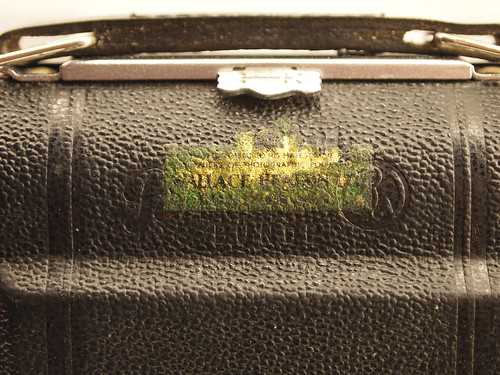 |
| Wallace Heaton label covering Balda-Werk Bünde stamp |
Looking at examples on the web, there are some production variations, although all seem to have a Schneider Kreuznach 105mm Radionar lens in either a
Prontor-S or
Prontor SVS shutter. Some have differences in the plate around the lens, with examples having a depth of field scale. My camera by comparison has a very plain
front plate. It also came with the original 6x4.5 mask, allowing for 16 exposures on a roll of film. Some
websites mention a 6x6 mask, although this would require a different arrangement of red windows on the back of the camera. It has frame lines in the viewfinder to indicate the 6x4.5 format, which are actually rather thick and do intrude on the viewfinder, which is very small, even for a camera of this age. I did remove the top plate to clean the viewfinder (as suggested by Flickr member
fulvue) making it slightly easier to use. There is also a
brilliant finder mounted to the lens, which can be rotated 90 degrees for both horizontal and vertical pictures, which seems to be quite a late date for this kind of finder, being more common on pre-war cameras.
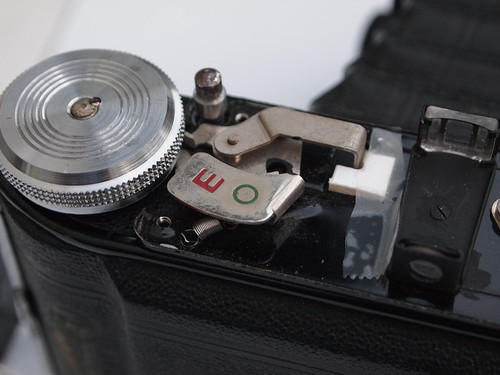 |
| A piece of card stops the double exposure prevention from working |
Another feature is the double exposure prevention, with a window on the top plate indicating 'O' for unexposed, and 'E' for exposed. However I have disabled the double exposure prevention. Shortly after I started using the camera, this began not to work very well: after winding on, it would spring back to the 'exposed' setting, preventing the shutter release on the camera from being depressed (although the shutter can always be tripped by the lever around the lens). I taped a small piece of card inside the mechanism to block it, making a non-destructive alteration to the camera. I've yet to accidentally double-expose a frame, but I'm sure that this will happen.
 |
| Roadworks, Berlin, shot on Ilford Delta 100 |
The
first photographs I'd taken with the Baldalux I had shot with the 6x4.5 mask, and I was impressed by the sharpness of the image. The Radionar lens is a triplet design (I believe the red triangle on the lens mount denotes coating), and while the centre of the image is very sharp, towards the edges of the full 6x9 frame there is a noticeable softness, however this does perhaps add to its vintage character.
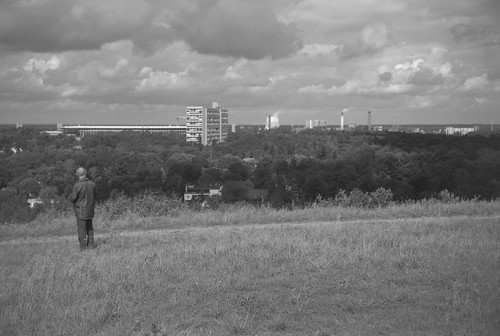 |
| View from the Teufelsberg, Ilford HP5 with yellow filter |
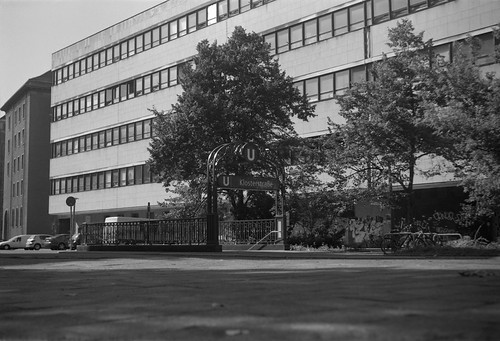 |
| Klosterstraße, Berlin, shot on Ilford HP5 |
 |
| Bahnhof Berlin Oranienburger Straße, Ilford Delta 3200 with 6x4.5 mask |
*I'm not actually sure that the camera was referred to as 'Zodel Baldalux', I've been searching online to no avail for old Wallace Heaton Blue Books which might show the camera.
Edit 28/2/18: more samples added.
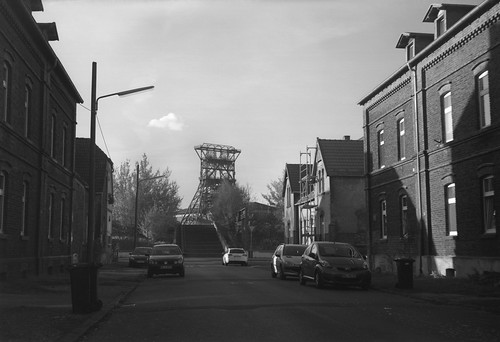 |
| Zodel Baldalux with Kodak Plus-X (develop before date 02/2007) |
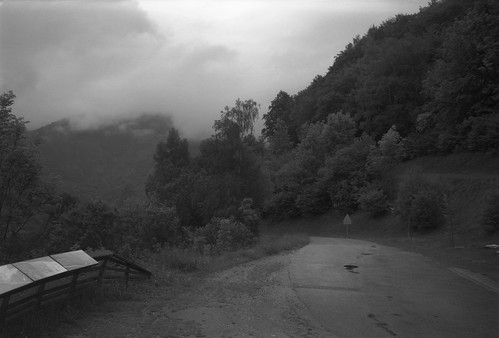 |
| Zodel Baldalux with Ilford FP4 Plus |
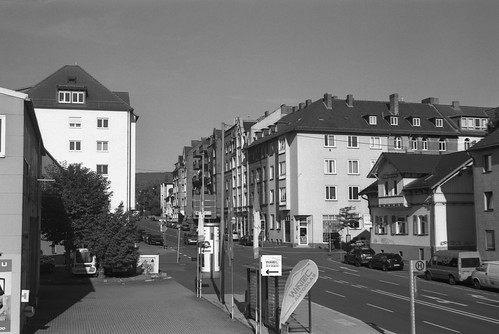 |
| Zodel Baldalux with Agfa Superpan |
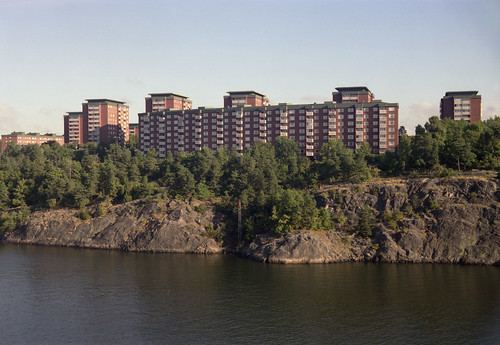 |
| Zodel Baldalux with Fujicolor Pro 400H |
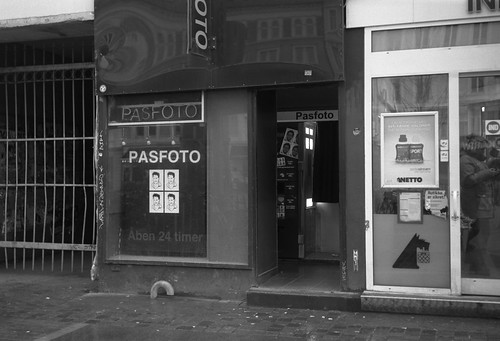 |
| Zodel Baldalux with Rollei RPX400 |
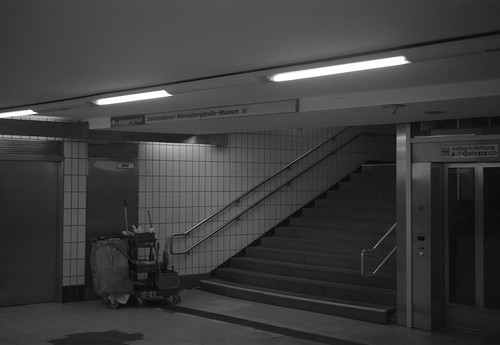 |
| Zodel Baldalux with Rollei RPX400 pushed to 1600 |
 |
| Zodel Baldalux with Ilford Delta 3200 pushed to 6400 |














I am very impressed with the quality of the B&W photos extremely sharp
ReplyDeleteI also do have a Bodelux body good condition but no lens i got a Voiklader Color Skopar 3.5/105 will fit and try but need to find the infinite focus first
I would be very grateful if anyone can advice me what id the focus range of this type of camera I guess may be 4-5 meters to infinite I will try out with a ground glass fitted on the film holder and see if i can adjust after i made a lens mount
Thank you for your comments. I've a Voigtlander folding camera with a 105mm lens (a Helomar lens,, though, not a Skopar) and it focuses right down to 1 metre. The Baldalux itself focuses to 3.5 feet, or 1.2m, but the lens on my Voigtlander is unit focusing, i.e. the whole thing moves forward to focus, not just the front elements.
DeleteRoadworks Berlin is absolutly sharp
ReplyDeleteCan you please tell me how was the Delta 100 developed
Is the above photo from a scan of a print?
Thank you
Peter M. schulz
The Ilford Delta film developed in R09 One Shot (Rodinal) diluted 1:25. I can't remember the time, but it would have been around the manufacturer's recommendation, possibly at 18 or 19 degrees C rather than 20, and the time adjusted accordingly.
DeleteAlso, the image was scanned from the negative.
DeleteI will now shortly try the first test camera complete lens calibrated to infinite
ReplyDeleteAre you posting your results somewhere? Would you mind sharing a link to them?
Delete